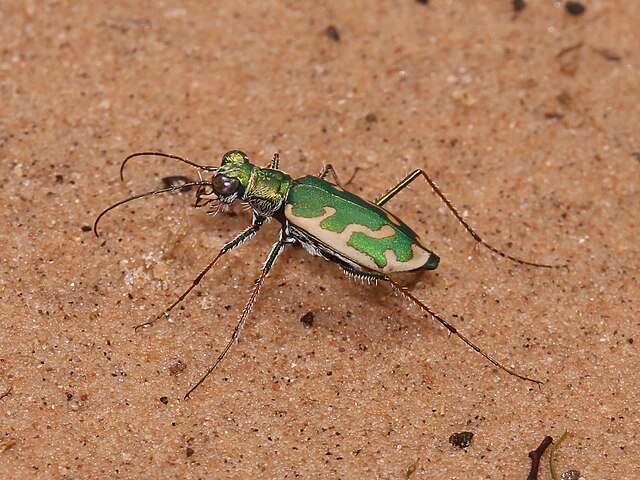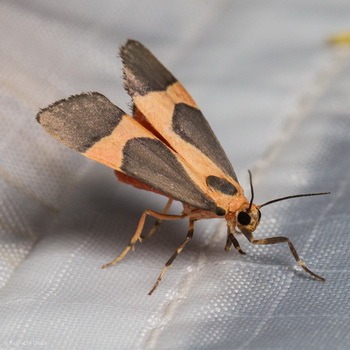Bats leave tasty tiger beetle alone

By mimicking the ultrasonic sound of noxious tiger moths, nocturnally active tiger beetles protect themselves against foraging bats, as Harlan Gough and colleagues write.
Some tiger beetles fly at night. It means that they must be afraid of hunting bats, predators that search for prey by emitting ultrasonic (very high-pitched) clicks and deducing from the reflected sound where a tree or a building is – or where a tasty insect snack is flying. This so-called echolocation allows bats to ‘see’ in the dark. Many insects perceive the ultrasonic clicks of an attacking bat and respond by fleeing or diving to avoid the enemy.
There are a few tiger beetles that react differently: they produce an ultrasonic sound in response to an approaching bat. Harlan Gough and colleagues wanted to know why.
Ultrasonic response
The only other insects known to respond with ultrasonic sound to a hunting bat are moths; an estimated 20 percent of moths responds, at a pitch that bats hear well. The sounds have several effects. Some moths disrupt the reflected bat sound by their calls, so that the bat no longer can interpret the noise. Other moths warn with their sound that they are distasteful or poisonous; once a bat has tasted such a species, it will leave it alone from then on. And other, non-poisonous moths benefit from this: they imitate the sound of a noxious species so that a bat let them also go.
And what about the tiger beetles that produce ultrasonic sound in response to a bat? What do they achieve by doing so?
The researchers tested nineteen tiger beetle species, beetles from the Cicindelidae family, from southern Arizona (USA). They exposed the beetles in the lab to the ultrasonic clicks of a bat that is about to attack. Seven of these nineteen species responded with their own ultrasonic sound, all being species that are active at night. The other twelve species stay put at night and therefore do not need to defend themselves against bats.
Tiger beetles and tiger moths
Do tiger beetles flying at night disrupt the echolocation of bats by jamming? No, the authors write, because that would require a more intensive sound (in technical terms: a higher duty cycle) than the beetles can produce.
Is their ultrasonic sound a warning that they are unpalatable? That is also not the case. The beetles do contain a repellent substance, benzaldehyde, which has an almond scent. But bats still like to eat them, as is evident from experiments with the big brown bat, Eptesicus fuscus. Apparently, the concentration of benzaldehyde is too low to deter this predator. The substance may help against small enemies such as ants and robber flies.
Maybe they imitate the ultrasonic sound of noxious moths? To evaluate that hypothesis, the researchers compared the sounds of tiger beetles with existing sound records of sympatric tiger moths, moths of the subfamily Arctiinae, some of which are poisonous. And yes: the sound produced by tiger beetles is similar to that of poisonous tiger moths. The beetles seem to practice acoustic mimicry.
Wings
Moths that produce ultrasonic sounds do so in diverse ways. They have special structures, such as tiny combs. Tiger beetles produce sounds by brushing their beating hindwings along the back edges of the rigid forewings, the elytra. Normally, they hold the elytra up during flight, but to make sound, they lower them slightly.
Definitive evidence for acoustic mimicry by tiger beetles is still lacking. This would require behavioural tests with bats to find out whether they indeed ignore the beetles after having tasted an unpalatable tiger moth.
Willy van Strien
Photos:
Large: Ellipsoptera marutha, Aridland Tiger Beetle, is one of the species that mimics tiger moths. Laura Gaudette (Wikimedia Commons, Creative Commons CC BY 4.0)
Small: unpalatable tiger moth Cisthene martini, Martin’s Lichen Moth. Ken-ichi Ueda (Wikimedia Commons, Creative Commons CC BY 4.0)
Sources:
Gough, H.M., J.J. Rubin, A.Y. Kawahara & J.R. Barber, 2024. Tiger beetles produce anti-bat ultrasound and are probable Batesian moth mimics. Biology Letters 20: 20230610. Doi: 10.1098/rsbl.2023.0610
Barber, J.R., D. Plotkin , J.J. Rubin, N.T. Homziak, B.C. Leavell, P.R. Houlihan, K.A. Miner, J.W. Breinholt, B. Quirk-Royal, P. Sebastián Padrón, M. Nunez & A.Y. Kawahara, 2022. Anti-bat ultrasound production in moths is globally and phylogenetically widespread. PNAS 119: e2117485119. Doi: 10.1073/pnas.2117485119
Corcoran, A.J., W.E. Conner & J.R. Barber, 2010. Anti-bat tiger moth sounds: form and function. Current Zoology 56: 358-369. Doi: 10.1093/czoolo/56.3.358
